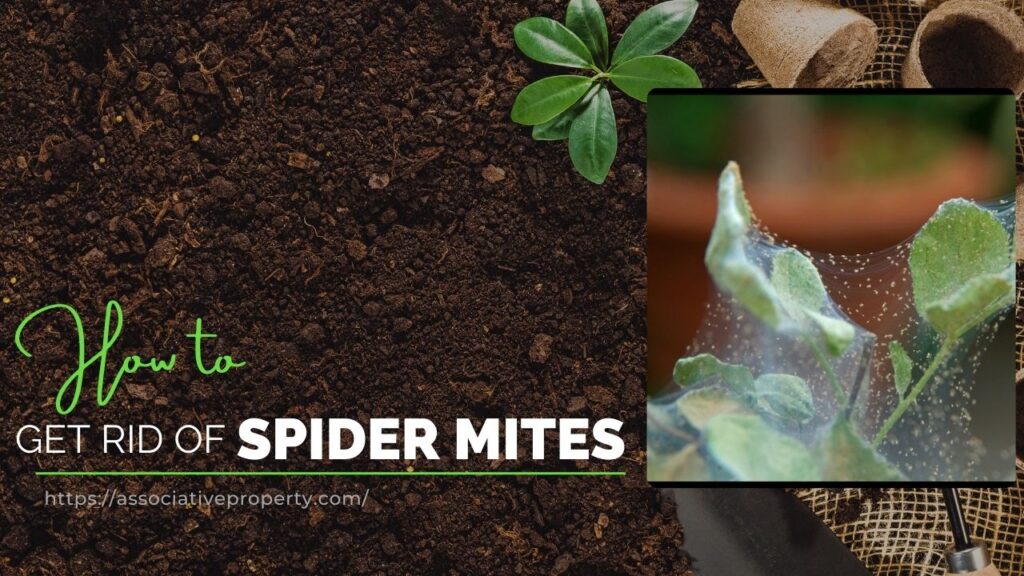Hi everyone, In this post, I’ll share my full experience of growing carrots from seeds all the way to harvest. I’ll tell you everything I did, step by step, and how you can do it too.
Carrot Growing: Quick Overview
| Category | Details & Figures |
|---|---|
| Ideal Soil Type | Loose, soft soil with good drainage |
| Preferred Soil Enrichment | Rich compost (hot compost used; no additional fertilizer) |
| Planting Time (Cool Climates) | Early Spring (2 weeks before last frost) or Autumn |
| Germination Time | 2 to 3 weeks |
| Height After 4 Weeks | Small seedlings visible |
| Height After 6 Weeks | About 4–6 inches |
| Height After 2 Months | Around 12 inches (1 foot) |
| Height After 3 Months | Around 18 inches |
| Watering Schedule | Keep soil consistently moist; natural rainfall may be enough |
| Harvest Time | After about 3 months of growth |
| Visibility at Maturity | Carrots do not emerge above soil; must scratch to check |
| Harvest Volume | 5–6 carrots per week for 6 weeks |
| Taste Comparison | More flavorful and sweeter than store-bought carrots |
| Spacing Between Seeds | 1 inch apart |
| Depth of Seed Planting | 0.5 inch deep |
| Row Spacing | 12 inches (1 foot) |
| Harvesting Tip | Some carrots pull easily, others need effort |
| Carrot Visibility Tip | Scratch soil to check instead of waiting for visible tops |
Why Carrots Are Special
Carrots are root vegetables. That means they grow under the soil, not above it. For that reason, they need loose and soft soil. If the soil is too hard or tight, the carrot roots won’t grow straight and healthy.
The Best Way to Prepare Soil
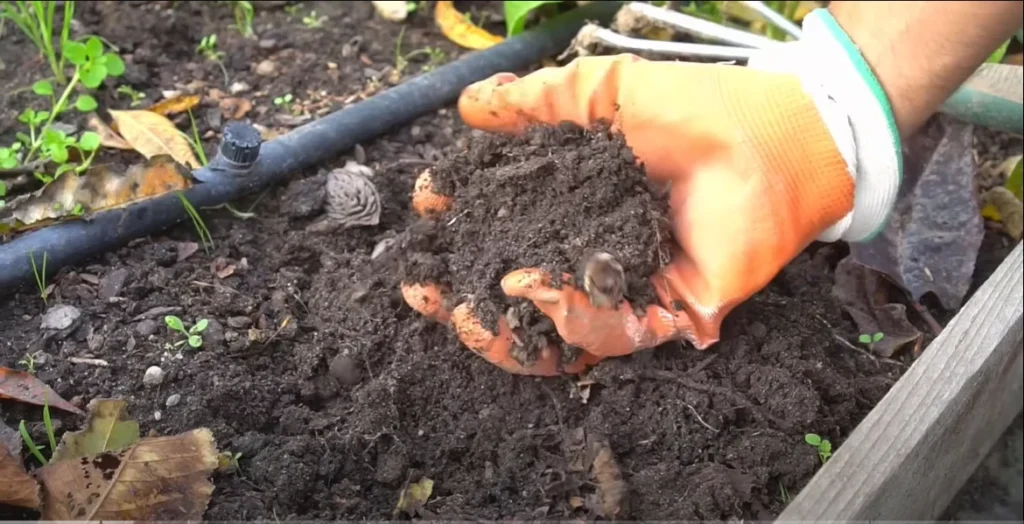
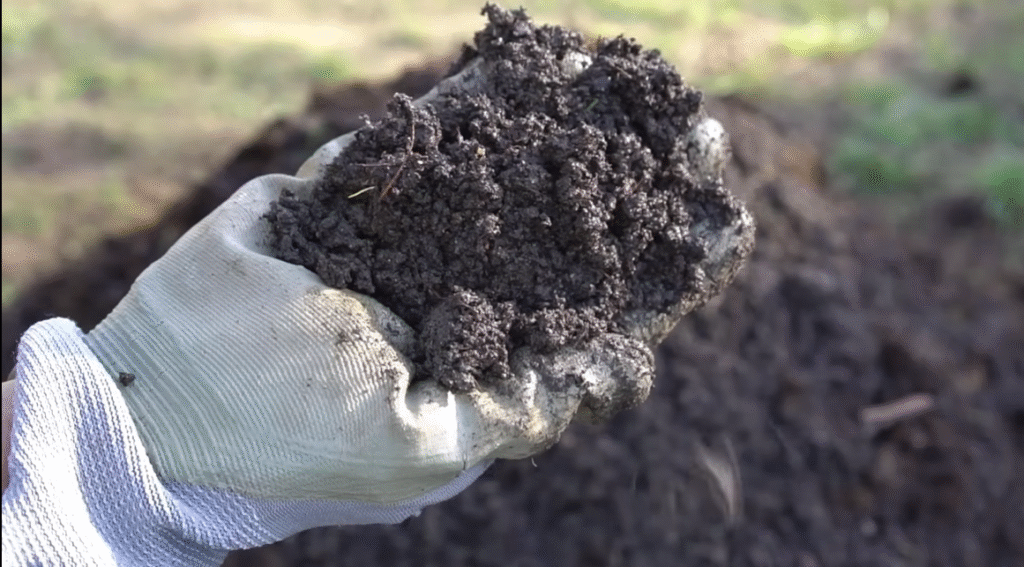
There are different ways to prepare the soil for carrots. You can:
- Use raised beds
- Build soil berms by heaping soil
- Add a lot of compost for better texture
Personally, I like to use raised beds filled with hot compost. If you want to make your own compost, I’ve made a full video on how to do it.
Since I add a lot of compost, I don’t need to use any extra fertilizers for my carrots.
Planting the Carrot Seeds

Carrot seeds are very tiny, so you have to handle them carefully. It’s easy to drop too many in one spot.
Here’s how I planted them:
- I used a hand trowel to make shallow rows
- Planted each seed about half an inch deep
- Left one inch between each seed
- Made rows that were one foot apart
After planting, I covered the seeds gently with soil.
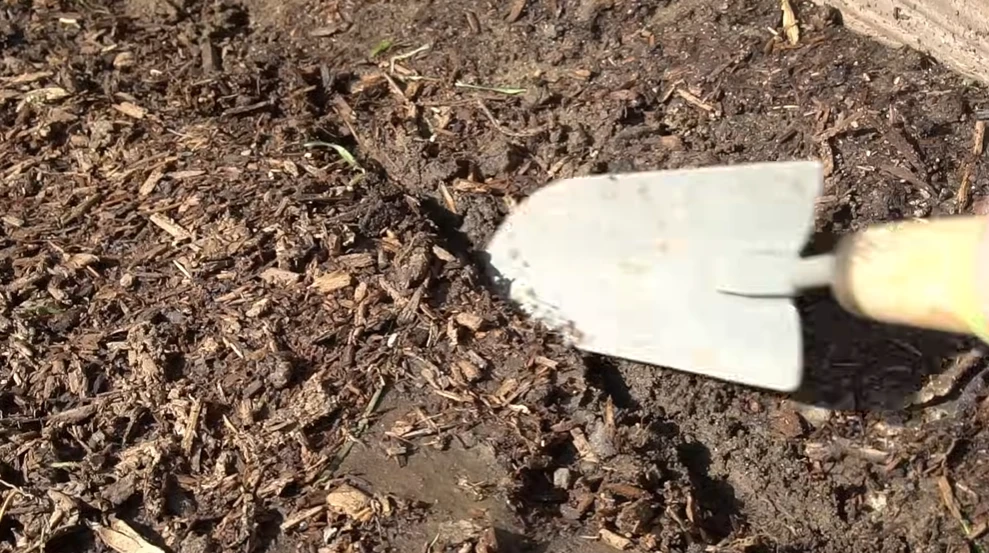
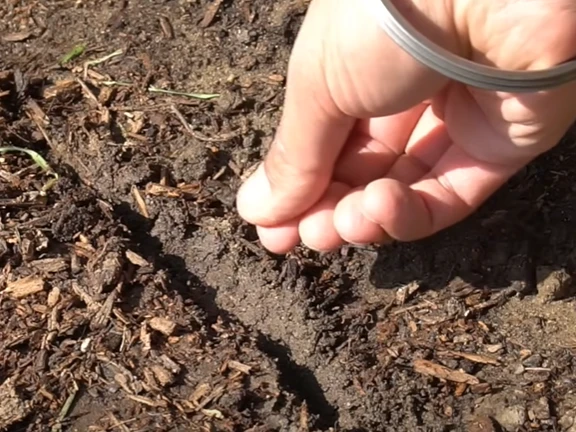
Quick Table: Seed Spacing and Depth
| Detail | Measurement |
|---|---|
| Seed Depth | Half inch |
| Seed Spacing | 1 inch apart |
| Row Spacing | 12 inches (1 foot) |
How Long They Take to Grow

Carrots grow slowly. So you’ll need patience.
Here’s what happened in my garden:
- 2–3 weeks: Seeds germinated
- 4 weeks: Carrot plants were visible
- 6 weeks: Plants were 4 to 6 inches tall
- 8 weeks: Plants reached about 12 inches
- 3 months: Plants were 18 inches tall, and carrots were ready
Carrots are a cool weather crop, so you should plant them in early spring (2 weeks before the last frost) or in autumn.
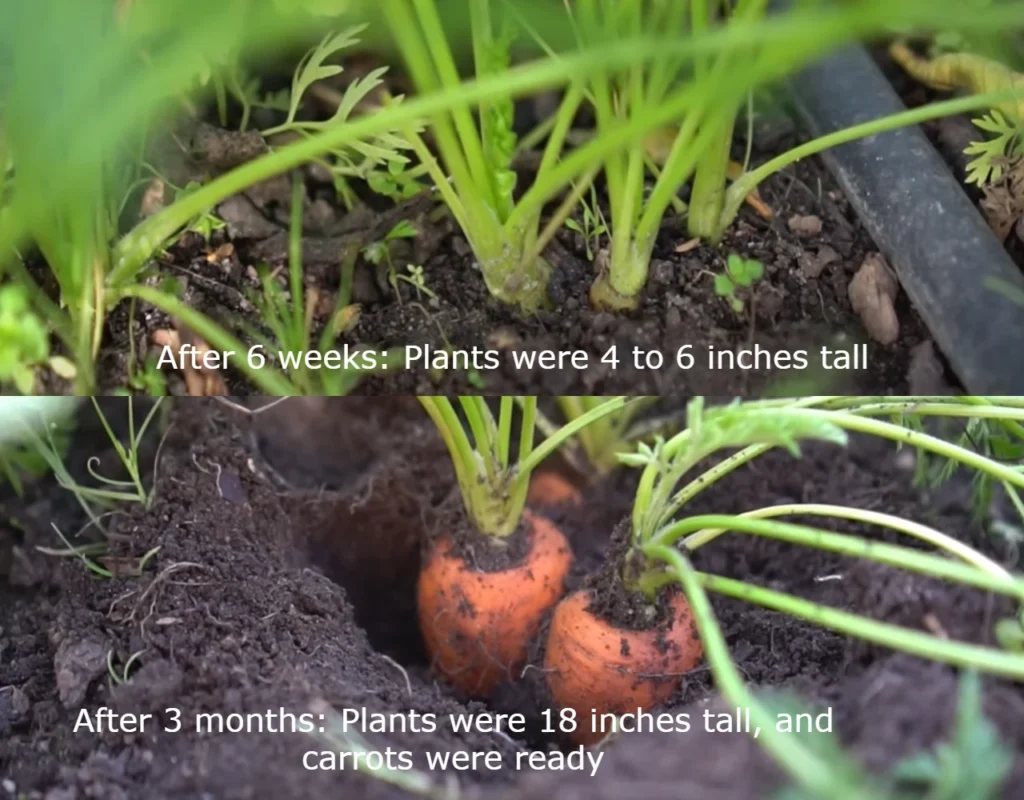
Watering the Carrots
Carrots need regular water, but you don’t want to flood the soil. The soil should stay moist, not dry or soaked.
Luckily, I live in California, and we had a lot of rain that season. I didn’t have to water my garden much at all during the fall and winter.
How to Know When Carrots Are Ready
After three months, I started seeing small signs of carrots growing under the soil. But carrots don’t show themselves like radishes or turnips do. You won’t see them sticking out.
To check if they’re ready:
- Gently scratch the soil surface
- Look for the top of the carrot peeking out
If it looks thick and orange, it’s time to harvest.
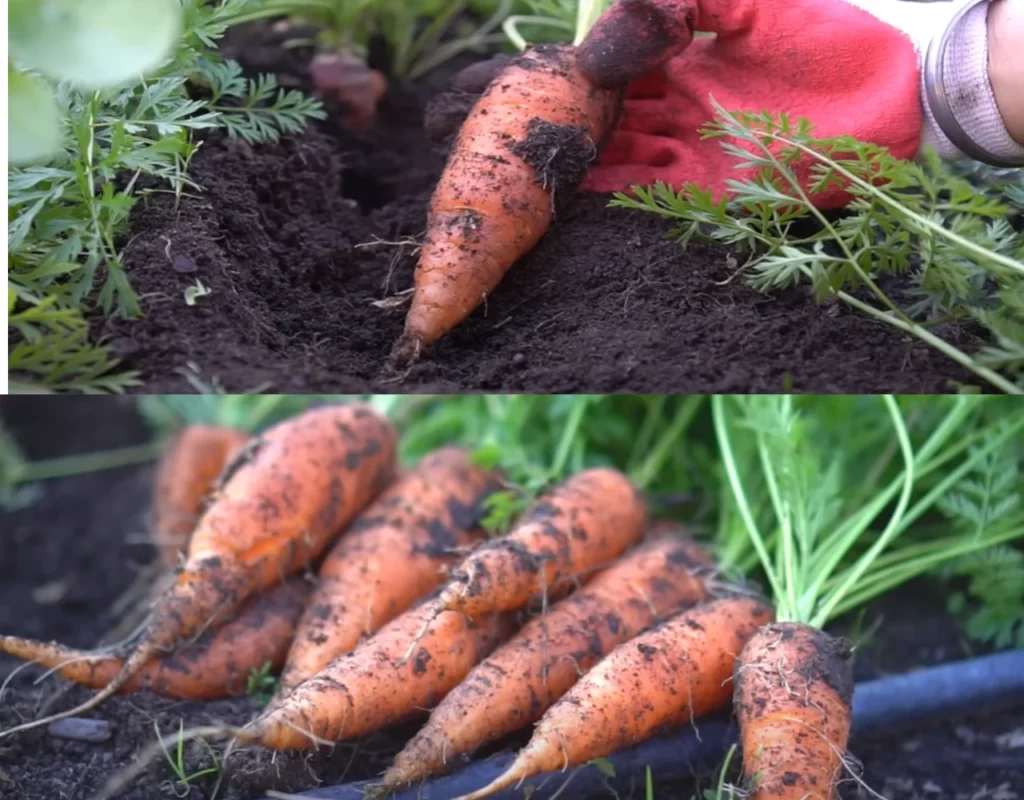
A Quick Story Before Harvest
Before I harvested my carrots, I remembered a funny story.
Once, a bus full of politicians crashed into a carrot farm. The farmer buried all of them. When the sheriff came and asked if they were all dead, the farmer replied, “Some said they weren’t… but you know how politicians lie.”
It still makes me laugh every time I think of it.
Time to Harvest
Now it was time to pull up the carrots. I had two growing right next to each other. I pulled one, then the second.
Some carrots were easy to pull. Others needed a little extra tug. But pulling carrots you grew yourself feels amazing.
Just one row gave me a bounty of beautiful carrots. I left the smaller ones in the ground so they could grow a bit more.
Harvest Results
Here’s how my harvest went:
- Pulled 5 to 6 carrots every week
- Continued for 6 weeks
- Got both big and small carrots
- All were sweet and flavorful
Honestly, they tasted way better than store-bought carrots.
After a wash, these carrots looked so fresh and bright orange. I couldn’t wait to cook with them.
Final Thoughts
Every week brought a few more carrots, and each one was a treat. If you haven’t tried growing carrots yet, I hope this inspires you to give it a shot.
Thanks for reading, and I’ll see you in the next story from my garden.
Frequently Asked Questions (FAQs) About Growing Carrots
1. What are the most common mistakes to avoid when growing carrots?
- Using hard or compacted soil is the most common mistake. Carrots need loose soil to grow straight.
- Overcrowding seeds without thinning them leads to stunted growth.
- Skipping consistent watering causes carrots to become woody or cracked.
- Harvesting too early can lead to underdeveloped carrots.
2. Which carrot varieties are best for home gardening?
- Nantes: Sweet, cylindrical, and easy to grow.
- Chantenay: Short and thick, good for heavy soil.
- Imperator: Long and slender, found in grocery stores.
- Danvers: Tapered roots, grows well in various soil types.
Each variety matures in about 70–80 days.
3. How and when should I thin carrot seedlings?
- Thin seedlings when they’re about 2 inches tall, usually 2–3 weeks after germination.
- Keep 1–2 inches of space between each plant after thinning.
- Thinning ensures that each carrot has space to grow without competition.
4. How can I tell if I’m overwatering or underwatering my carrots?
- Overwatering: Yellowing leaves, root rot, or fungal growth.
- Underwatering: Wilted leaves and short, dry roots.
- Carrots need 1 inch of water per week, but soil should stay consistently moist, not soggy.
5. How can I prevent pests naturally in carrot beds?
- Use neem oil spray to deter pests.
- Plant onions, leeks, or garlic nearby as natural pest repellents.
- Install row covers to protect from carrot rust flies.
6. How should I store carrots after harvesting?
- Wash and dry them thoroughly.
- Store in the fridge in a plastic bag for up to 4 weeks.
- For longer storage, pack unwashed carrots in damp sand or sawdust in a cool, dark place (32–40°F or 0–4°C).
7. What plants grow well with carrots?
- Good companions: Onions, leeks, lettuce, tomatoes, rosemary, and peas
- Avoid: Dill and parsnips, as they can attract pests or compete with carrots.
8. How can I improve soil texture for better carrot growth?
- Mix in compost and sand to loosen clay or compact soil.
- Avoid using manure right before planting, as it causes root branching.
- Ideal soil pH is between 6.0 and 6.8.
9. Why are my carrots deformed or split?
- Caused by rocky or clumpy soil, or inconsistent watering.
- Forked carrots often happen due to obstructions in soil like stones or hard clumps.
- Splitting occurs when carrots absorb too much water too quickly after dry periods.
10. How does the growing season affect carrot flavor and size?
- Carrots grown in cooler temperatures are sweeter due to sugar buildup in roots.
- Carrots grown during hot weather may become woody or bitter.
- Best temperature range: 55–75°F (13–24°C)
11. What tools do I need to grow carrots successfully?
- Hand trowel or small spade
- Garden fork for loosening soil
- Watering can or hose with gentle spray
- Row markers or twine for straight planting
- Mesh or row covers for pest protection
12. Should I use compost or fertilizer for carrots?
- Compost is best. It improves soil texture and adds nutrients slowly.
- Avoid high-nitrogen fertilizers—they lead to more leafy tops and fewer roots.
- If needed, use balanced or phosphorus-rich fertilizer (like 5-10-10).
13. Can I grow carrots indoors?
- Yes, if you have deep containers (at least 10 inches) and access to 6+ hours of sunlight or strong grow lights.
- Use light, fluffy potting mix and water regularly.
- Great varieties for containers: Thumbelina, Parisian, or Little Finger
14. What’s a month-by-month timeline for growing carrots?
| Month | Task |
|---|---|
| Early March | Start planting if climate permits |
| April | Germination begins |
| May | Thin seedlings, continue watering |
| June | Foliage thickens, carrots enlarge |
| July | Begin checking for maturity |
| August | Start harvesting early carrots |
| September | Main harvest season |
Note: This timeline applies to temperate zones with a spring planting.
15. Can I save carrot seeds for next season?
- Yes, but carrots are biennial, so they produce seeds in the second year.
- Let some plants overwinter and flower the following year.
- Collect seeds when the flower heads dry out and turn brown.

